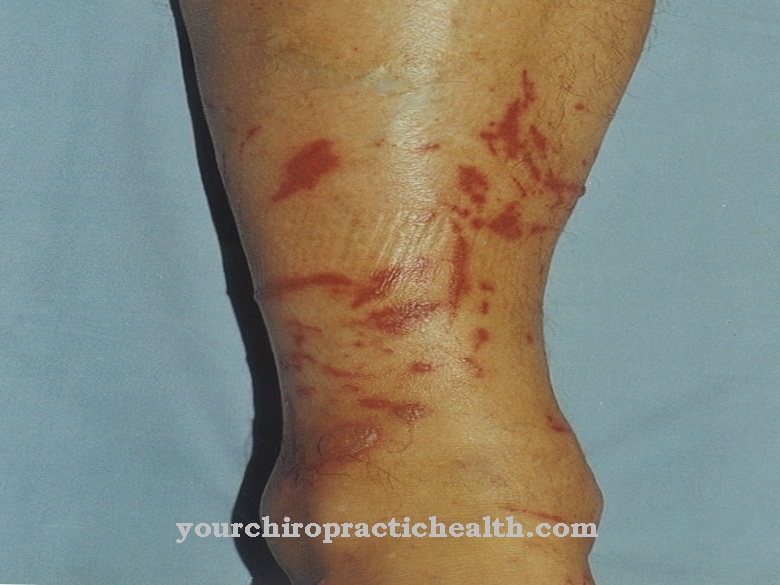A Hantavirus infection is notifiable in Germany and can be difficult. Successful therapies depend on the type of hantavirus infection.
What is a hantavirus infection?

© Kanyarat - stock.adobe.com
The hantavirus infection is an infectious disease that can be caused by various forms of the hantavirus.
The hantavirus infection can be found to varying degrees around the world; for example, the infection is relatively widespread in Southeast Asia. Cases of hantavirus infection also occur in Europe: a relative accumulation can be observed here, for example in the Balkans or in parts of Scandinavia. The hantavirus infection was named after the South Korean river Hantan, where many soldiers fell ill with the virus during the Korean War in the 1950s.
In Germany, a hantavirus infection has been notifiable since 2001. According to the Robert Koch Institute (a federal institute that is familiar with infectious diseases, among other things), the hantavirus infection was on average one of the five most common viral diseases in 2007 that were subject to mandatory reporting.
causes
The hantavirus infection is mainly transmitted to humans by rodents. Infection can take place from person to person, but this happens comparatively rarely.
Transmission of the hantavirus infection by rodents takes place primarily through animal excretions; The hantavirus infection pathogens are then absorbed by humans through the air they breathe. Due to this source of transmission, people who frequently come into contact with the potential excretions of such rodents are particularly at risk:
For example, people who are employed as hunters, foresters or soldiers and who are relatively often in forests where rodents are at home are at higher risk of hantavirus infection.
You can find your medication here
➔ Medicines for fever and chillsSymptoms, ailments & signs
A hantavirus infection can express itself through very unspecific symptoms. As a rule, symptoms similar to flu at the beginning such as suddenly occurring high fever with chills, headache and body aches. The eyes are often extremely sensitive to light, and visual disturbances are also possible. Occasionally, there are also coughs, sore throats, diarrhea, vomiting and abdominal pain.
Depending on the type of pathogen, the infection can spread to the kidneys or the lungs: If the kidneys are involved, blood is often found in the urine, and the amount of urine also decreases significantly. Protein can be detected in large quantities in the urine. Further alarm signs are the smallest bleeding (petechiae) into the skin, the mucous membrane and the conjunctiva of the eyes as well as a significant drop in blood pressure.
If the course is severe, the progressive infection leads to complete kidney failure; in rare cases, inflammation of the heart muscle (myocarditis), inflammation of the thyroid gland (thyroiditis), liver inflammation (hepatitis) or dysfunction of the central nervous system can occur as part of a hantavirus infection.
Possible signs of lung involvement are severe coughing and increasing shortness of breath, which can lead to life-threatening acute respiratory distress syndrome (ARDS). Hantavirus infections run very differently, often they go unnoticed due to the mild symptoms or are mistaken for a harmless cold. Severe forms, especially those with life-threatening involvement of the airways, are rare in Europe.
Diagnosis & course
In order to be able to diagnose a hantavirus infection, a diagnostician often first collects data on the occupational activity of a patient and on his daily environment. This can serve as an initial risk assessment with regard to a hantavirus infection.
Further sources of information for the diagnostician for the diagnosis of a hantavirus infection are the so-called clinical (i.e. the observable or currently present) symptoms of a patient and various laboratory values (such as blood values).
The course of a hantavirus infection can vary greatly depending on the form of the hantavirus and the patient. In severe cases, a hantavirus infection can be fatal. The incubation period (i.e. the time between infection and the first noticeable symptoms) of the hantavirus infection can be approx. 1-5 weeks.
Possible first symptoms of a hantavirus infection are, for example, fever, chills, muscle pain or pain in the lumbar spine. Depending on the form of a hantavirus infection, coughing, vomiting or diarrhea can also occur. Severe cases show up as kidney inflammation or bleeding of the gastrointestinal tract.
Complications
In the worst case, the hantavirus infection can lead to death of the patient. Without treatment, there is no automatic healing process. As a result of this infection, the affected person suffers from fever and pain in different parts of the body. As a result, muscles and joints ache and there is a sharp headache that can spread to the back.
Abdominal pain, sometimes even diarrhea or vomiting, also occur. The patient can also suffer from a dry cough and usually also develop conjunctivitis. The patient's everyday life becomes more difficult and the person concerned feels tired and exhausted. Active participation in life is usually not possible due to the symptoms of the hantavirus infection. It can also spread to other patients quickly.
In the worst case, it can lead to inflammation in the kidneys, which can lead to renal insufficiency. If left untreated, this can lead to patient death. Treatment takes place with the help of medication and is usually successful if started early. There are no further complications. After treatment, the affected person is usually immune to the hantavirus infection.
When should you go to the doctor?
Hantavirus infection is treated symptomatically. Depending on the type of virus and the immune system of the infected person, there may be no or life-threatening symptoms. In the event of an infection with the hantaviruses that occur in North and South America, there is a risk of severe pneumonia with pulmonary edema, which requires medical supervision or treatment.
It is therefore advisable to consider the possibility of a hantavirus infection when you are on the American continent if you experience sudden lung problems and to consult a doctor immediately. Asian and European strains of the hantavirus can cause HFRS (hemorrhagic fever with renal syndrome) if the infection is severe; In these cases, too, medical care is essential.
If symptoms of the first phase such as high fever, chills, headache and body aches, red eyes, nausea, abdominal and / or back pain, then there is a risk of the onset of a further, possibly life-threatening phase of the infection, which ends with kidney failure can.
The doctor must be consulted if the symptoms of the first phase are mentioned. In addition, an infection with the hantavirus must be reported, although it is not always recognized by the doctor or the person affected if it progresses slightly or because of its flu-like symptoms.
Doctors & therapists in your area
Treatment & Therapy
The successful therapy of a hantavirus infection depends, among other things, on the diagnosed form of a hantavirus infection and the symptoms present. It often makes sense to have a hantavirus infection treated in clinics which, if necessary, have an adequate intensive care unit.
Analgesics (drugs to combat pain) or so-called antipyretics (to fight fever) are used purely for treating symptoms of a hantavirus infection. If an infection-related impairment of the kidneys is found in an affected person, checks of the fluid balance and, if necessary, a compensation of the fluid balance may be necessary in the therapy of a hantavirus infection.
If, in the course of a hantavirus infection, the kidneys fail, for example, there are possible therapeutic steps in so-called hemodialysis (blood washing that takes place outside the body with the help of an 'artificial kidney').
If lung function is impaired during the course of the hantavirus infection, ventilation in an intensive care setting can be a therapeutic step. After successful treatment of a hantavirus infection, the affected person is usually immune to the treated form of the hantavirus infection.
Outlook & forecast
Statistically speaking, the hantavirus causes death in rare cases in Europe. Viruses from rodents are hardly aggressive here. The situation is different in Asia and South America. Scientists have not only detected far more dangerous pathogens there. Rather, the climatic conditions there also offer good living and distribution conditions. The hygienic conditions allow contact with rats and mice and their excretions.
The infection with the hantavirus usually subsides without any residual damage. A medically prescribed therapy brings about improvement in a short time. Only the so-called Hantavirus Pulmonary Syndrome has a mortality rate of 50 percent. Most death is caused by organ failure. Those who adhere to the usual hygiene standards in Europe will hardly come into contact with infected rodents.
People at risk work almost exclusively in agriculture. After successfully fighting the virus, one remains immune to the pathogen for decades. So far there is no vaccine for the prevention of hantaviruses.
Overall, it can be said that infection with hantaviruses usually goes well in Germany. The prospect of complete cure is to be classified as very favorable given the less aggressive pathogen.
You can find your medication here
➔ Medicines for fever and chillsprevention
Although there is still no approved vaccination against a hantavirus infection, appropriate preventive measures can reduce the risk of a hantavirus infection. If, for example, places are cleaned of mouse or rat droppings (such as barns or attics), moistening the excrement beforehand or wearing respiratory protection can reduce the risk of hantavirus infection.
Aftercare
In the case of a hantavirus infection, the measures or the direct options for follow-up care are in most cases severely limited. The focus is on the early detection and treatment of the disease so that there are no further complications or upsets. The earlier the disease is recognized by a doctor, the better the further course will usually be.
Therefore, those affected should consult a doctor at the first symptoms or signs of the hantavirus infection. Treatment for this infection is most often done with medication. Those affected must ensure that they are taken regularly with the correct dosage. Side effects or interactions should also be considered.
If you have any questions or are unclear, you should always contact a doctor first. Furthermore, regular control of the internal organs in the case of a hantavirus infection is very important, with the kidneys being checked in particular. In some cases, those affected are dependent on dialysis. It is often necessary to care for and support your own family or friends in order to properly alleviate the symptoms. This infection may also reduce the life expectancy of the person affected.
You can do that yourself
A hantavirus infection is always treated with medication. The person affected can support the administration of analgesics and anapyretics through a number of measures.
First and foremost, bed rest is important. Since it is a classic viral disease, the typical measures can be taken. In this way, it helps to adjust the diet and no longer consume food that could irritate the gastrointestinal tract. In addition, the body temperature should be measured regularly.
Consult a doctor if the fever suddenly rises or falls. The person concerned should also drink plenty of water and compensate for any loss of fluid and nutrients due to supplements. In severe cases, the sick person has to go to a hospital.
After intensive medical care, the body is very weak and should be spared for at least two to three weeks. In addition, a close inspection by a doctor is indicated, because complications can only be excluded by regularly checking the blood values and the general health of the patient. If signs of a renewed outbreak of the hantavirus infection become noticeable after the treatment, the responsible doctor must be consulted immediately.



.jpg)





















.jpg)


